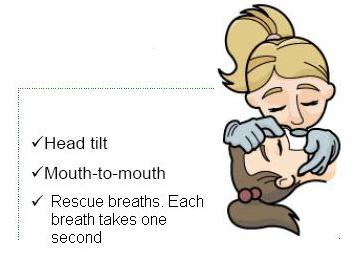Child (Mouth-to-Mouth Technique)
 For a child rescue breaths are the same as adult rescue breaths, with the following changes:
For a child rescue breaths are the same as adult rescue breaths, with the following changes:
- When breathing into a child's mouth only use enough exhaled air to achieve rise and fall of the child's chest. For some children this may require only half a normal adult breath.
- Head tilt for a child needs to be appropriate to the child's size.
Infant (Mouth-to-mouth technique)
For an infant rescue breaths are the same as for an adult, with the following changes:
- Do not use full head tilt, use a modified head tilt which is supporting the head in a horizontal (neutral) position.
- Gain a seal around the infant's mouth and nose with your lips.
- Fill your mouth with air and 'puff' it into the infant's mouth.
Managing other life threatening situations
There are many other potentially life threatening situations that may eventually lead to cardiac arrest. These include choking, near drowning and shock.
Choking
Any object that has been caught in the upper part of the airway can cause choking. Choking is an emergency and first aid management should be delivered immediately. The casualty has trouble breathing with a partial obstruction and cannot breathe at all with a total obstruction. Signs and symptoms of choking can include:
- Noisy breathing, or making a whistling noise
- Wheezing and/or coughing, gagging
- Gasping for breath
- Reddened or blue colouration in the face or fingernails
- Panic
- The casualty may also clutch their own throat area with one or both hands
- Small children may go quiet or be unable to speak
- Having trouble speaking or swallowing
Management of choking
- DRSABCD
- If they are able to, encourage the casualty to cough repeatedly until the blockage is expelled
- If coughing does not remove the blockage, or the casualty is an infant DRSABCD and call 000 or 112 for an ambulance
- Give five (5) back blows with the heel of your hand between the casualty's shoulder blades
- If unsuccessful, Give five (5) chest thrusts - check after each chest thrust if the object is expelled
- Continue giving five (5) back blows, followed by five (5) chest thrusts until medical aid arrives
If the casualty is unconscious:
- Call 000 or 112 for an ambulance
- Remove any visible obstruction from mouth
- Commence CPR
Drowning
Drowning occurs when a casualty gasps for air while struggling to stay afloat. If water is inhaled into the airway, the muscles in the throat will spasm causing the airway to close. While the closure of the airway prevents more water from being inhaled, it also prevents air from entering the lungs. Unconsciousness and cardiopulmonary arrest will soon follow. Signs and symptoms of near drowning can include:
- Choking or gasping for air
- Pale or blue colour to the face and lips
- Struggling in the water
- Floating face down in the water
- Unconsciousness
Management of drowning
- Assess the scene
- Remove the casualty from the water, but only if it is safe to do so
- Follow DRSABCD and call 000 (112 digital mobile phones)
- Place the casualty in the recovery position
- Clear the casualty's airway, allowing water and/or vomit to drain
- Assess breathing - if no breathing is evident, commence rescue breaths
- Check for signs of life. If none, commence CPR
- Closely monitor signs of life
 For a child rescue breaths are the same as adult rescue breaths, with the following changes:
For a child rescue breaths are the same as adult rescue breaths, with the following changes:  For a child rescue breaths are the same as adult rescue breaths, with the following changes:
For a child rescue breaths are the same as adult rescue breaths, with the following changes: